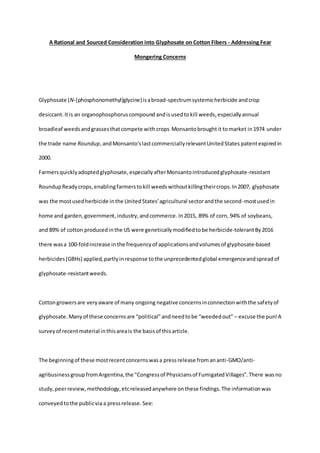Glyphosate on Cotton Fibers September 2016
- 1. A Rational and Sourced Consideration into Glyphosate on Cotton Fibers - Addressing Fear Mongering Concerns Glyphosate (N-(phosphonomethyl)glycine)isabroad-spectrumsystemicherbicide andcrop desiccant.Itis an organophosphoruscompound andisusedtokill weeds,especiallyannual broadleaf weedsandgrassesthatcompete with crops Monsantobroughtit tomarket in1974 under the trade name Roundup,andMonsanto'slastcommerciallyrelevantUnitedStates patentexpiredin 2000. Farmersquicklyadoptedglyphosate,especiallyafterMonsantointroducedglyphosate-resistant RoundupReadycrops,enablingfarmerstokill weedswithoutkillingtheircrops.In2007, glyphosate was the mostusedherbicide inthe UnitedStates'agricultural sectorandthe second-mostusedin home and garden,government,industry,andcommerce. In2015, 89% of corn, 94% of soybeans, and 89% of cotton producedinthe US were geneticallymodifiedtobe herbicide-tolerantBy2016 there wasa 100-foldincrease inthe frequencyof applicationsandvolumesof glyphosate-based herbicides(GBHs) applied,partlyinresponse tothe unprecedentedglobal emergenceandspreadof glyphosate-resistantweeds. Cottongrowersare veryaware of many ongoing negative concernsinconnectionwiththe safetyof glyphosate.Manyof these concernsare “political”andneedtobe “weededout” – excuse the pun!A surveyof recentmaterial inthisareais the basisof thisarticle. The beginningof these mostrecentconcerns wasa pressrelease fromananti-GMO/anti- agribusinessgroupfromArgentina,the "Congressof Physiciansof FumigatedVillages".There wasno study,peerreview,methodology,etcreleasedanywhere onthese findings.The informationwas conveyedtothe publicvia a pressrelease. See:
- 2. http://www.reduas.com.ar/declaration-of-the-3rd-national-congress-of-physicians-in-the-crop- sprayed-towns/ The pressrelease fromthis“Congress”wasthenpickedupbymany eco/earthblogs forexampleat: http://ecowatch.com/2015/10/26/cotton-glyphosate-cancer/ https://www.rt.com/usa/319524-tampons-cotton-glyphosate-monsanto/ http://www.naturalnews.com/051669_tampons_glyphosate_GMO_cotton.html A furthergroupof scientists hasputouta pressrelease ontheirfindingsbeforepublishingastudyor waitingforcompletionof the peerreview process. http://www.laolla.tv/2015/10/el-glifosato- tambien-en-tu-botiquin/ Reportingtonewsagenciesbeforepeerreview isthe same tacticusedbyotheranti-GMOgroups, such as Gilles-EricSeralini inhisnowinfamousGMOrat feedingstudy,whichhassince been retracted. See http://www.vegangmo.com/?p=711 It needstobe notedthat glyphosate canbe foundat these levelsonanythingthatgrowsinsoil oris subjectedtorainfall inagricultural areas.Theseare referredtoas“backgroundlevels”andcanbe confirmedthroughtestingof rain,watersystems,un-farmedsoil,andfood. Rainwatercontains2.5 ppb:http://www.ncbi.nlm.nih.gov/pubmed/21128261 and our surface waterscontaintrace amountsof glyphosate: http://www.ncbi.nlm.nih.gov/pubmed/21681915. The researchers responsible forthispressreleaseintheirownformerstudyevenshowsthatun-farmedsoilcontains 5 ppbof glyphosate: http://www.ncbi.nlm.nih.gov/pubmed/26254069 .Furthermore, there is glyphosate infoodsthatwe eatat much higherlevelsthanthose foundoncotton.See:
- 3. http://www.ncbi.nlm.nih.gov/pubmed/1783592 and http://ec.europa.eu/environment/archives/ppps/pdf/ma_reding_annex4.pdf Anyglyphosate foundoncottonfibreswouldlikelybe fromresidential/commercialusage,rainwater or soil,asthere are no fieldpracticesduringcottonharvestseasonwhichutilize glyphosate. For instance, RoundupReady cottonplantsare appliedwithglyphosate,butinnormal production practicesthisoccurs monthsbefore the cottonfibresare evenformedbythe plant. The World HealthOrganizationhassetthe lowestNOAEL(NoObservedAdverse EffectLimit) for glyphosate as.15 g/kg formaternal toxicity(http://www.fao.org/docrep/w8141e/w8141e0u.htm ), and the "findings"fromthisgroupclaimthattheyfound4ppbon tampons.Giventhata tampon containsabout5 grams of fibre,a single tamponwouldcontain.000000002 grams of glyphosate. Since NOAELreferstooral toxicity,a60 kg expectingmotherwouldtheoreticallyneedtoingest (note:DONOT EAT TAMPONS) 750 milliontamponsbefore anynegativeeffectswouldbe expected. Furthermore,glyphosate itselfisnon-toxic,non-carcinogenic,non-teratogenic,andnon-mutagenic. It isthe safestherbicideeverusedbymanand has replacedfarmore dangerousherbicidessuchas atrazine,gramoxone,andotherorganophosphate herbicides. http://npic.orst.edu/factsheets/glyphotech.html http://www.bfr.bund.de/en/the_bfr_has_finalised_its_draft_report_for_the_re_evaluation_of_glyphosat e-188632.html http://www.ncbi.nlm.nih.gov/pubmed/15626647 http://www.efsa.europa.eu/en/efsajournal/pub/4302 The onlycredible grouptoeverclassifyglyphosate asa“probable”carcinogenisthe International AgencyforResearchon Cancer (IARC),anarm of the WHO. Thissame group has recentlyclassified manyother itemsas“probably”carcinogenic,suchascured meats,night-shiftwork,andworkingat a barbershop. See https://www.iarc.fr/en/media-centre/iarcnews/pdf/MonographVolume112.pdf
- 4. Many groupshave since thenrefutedthe IARC’sfindings.Some examples whichI’ve searchedand thenquoted include: European Crop ProtectionAssociation {The IARCconclusionspublishedinLancetOncologycontradictthe world’smostrobustandstringent regulatorysystems –namelythe EuropeanUnionandthe UnitedStates – inwhichcrop protection productshave undergone extensive reviewsbasedonmulti-yeartestingandinwhichactive ingredientssuchasglyphosate andmalathionbeenfoundnottopresentacarcinogenicriskto humans.”“Fromthe summaryconclusionsitappearsthatIARChas made itsconclusionsasa resultof an incomplete datareviewthathasomittedkeyevidence.} http://www.ecpa.eu/news-item/human-health/03-19-2015/2565/ecpa-statement-reacting-iarc- review-pesticides American Cancer Society {Evenif a substance or exposure isknownorsuspectedtocause cancer,thisdoesnotnecessarily meanthat it can or shouldbe avoidedatall costs.For example, oestrogenisaknowncarcinogen that occurs naturallyinthe body.Also,exposure toionizingradiationisknowntocause cancer,with increasedrisksevenatlowlevelsof exposure.Yetthere isnowayto completelypreventexposureto natural sourcesof radiationsuchas cosmicradiationfromthe sunor radonin soil.These listsalso include manycommonlyusedmedicines,particularlysome hormonesanddrugsusedtotreat cancer. For example,tamoxifenincreasesthe riskof certainkindsof uterine cancer butcan be very useful intreatingsome breastcancers,whichmaybe more importantforsome women.} See: http://www.cancer.org/cancer/cancercauses/othercarcinogens/generalinformationaboutcarcinogen s/known-and-probable-human-carcinogens
- 5. US Environmental ProtectionAgency {InMarch 2015, the IARC evaluatedthe carcinogenicpotential of glyphosate.The IARC determinedthatthere wasa positive trendinthe incidence of arare tumourtype,renal tubular carcinomaand renal tubule adenomaorcarcinoma(combined) inmalesinone feedingstudyin CD-1 mice.A secondstudyreportedapositive trendforhemangiosarcomasinmale CD-1mice. Thus,in accordance withone of the preamble criteria,“the occurrence of tumoursintwostudiesin one species,”IARCdeterminedthatthere is“sufficientevidence”inexperimental animalsforthe carcinogenicityof glyphosate (IARC,2015) In contrast,the USEPA’scarcinogenicityclassificationisbasedonweight-of-evidence considerations inaccordance withthe agency’s2005 GuidelinesforCarcinogenRiskAssessment.The cancer guideline emphasizesthe importance of weighing all of the evidenceinreachingconclusionsabout the humancarcinogenicpotential of agents.Thisevaluationisaccomplishedinasingle integrative stepafterassessingall of the individual linesof evidence.Evidenceconsideredincludestumour findings,orlackthereof,inhumansandlaboratoryanimals;anagent’schemical andphysical properties;itsstructure-activityrelationships(SARs)ascomparedwithothercarcinogenicagents; and studiesaddressingpotential carcinogenicprocessesandmode(s) of action,eitherinvivoorin vitro.Data fromepidemiological studiesare generallypreferredforcharacterizinghumancancer hazard andrisk.However,all of the informationdiscussedabovecouldprovidevaluable insightinto the possible mode(s) of actionandlikelihoodof humancancerhazardand risk(USEPA,2005) The IARC attributedthe kidneytumoursobservedinmale CD-1mice at the highdose inthe feeding study(MRID No.00251007) to treatmentsince theyare rare and there wasborderline significancein trendtest(P=0.034 for carcinomaand P=0.037 for combinedadenomaorcarcinoma) ina Cochran-
- 6. Armitage trendtest.However,the agency’sstatisticalanalysesdidnotshow asignificanttrendfor eithercarcinoma(P=0.06345) or the combined adenomaorcarcinoma(P=0.06483). In a Fisher’s exacttest,whencomparedtothe concurrentcontrol,there wasnopairwise significance forany tumourtype (adenoma,carcinoma,orcombined).There werenopre-neoplasticrenal tubular lesionssuchastubularnecrosis/regeneration,hyperplasiaorhypertrophy,despiteahighdose level (4945 mg/kg/day) thatwasapproximately5-foldhigherthanthe limitdose (1000mg/kg/day) recommendedbythe agency’sguidelines.Examinationof multiple sectionsof kidneysfromall animalsbymore than one pathologistdidnotresultinanyadditional neoplasms.Althoughthe highestdose tested(4945mg/kg/day) wasapproximately5-foldhigherthanthe limitdose (1000 mg/kg/day) recommendedbythe agency’sguideline,the incidence of the kidneytumourswas minimal (1/50adenomasand2/50 carcinomas) comparedtocontrols(1/49 adenomas).An evaluationbythe PWGconcludedthatthe renal tumoursare not treatment-relatedsince therewere no compoundrelatednephrotoxiclesions,includingpre-neoplasticchanges,multipletumourswere not foundinanyanimals,andthere wasno evidence of asignificantlineartrendatthe 0.5 level ina one-tailedCochran-Armitagetestorpairwise significance inaFisher’sexacttest.Furthermore, kidneytumourswere notseenwhentestedatlower(85to 1000 mg/kg/day) dosesorat a comparable (4116 mg/kg/day) dose inthisstrainof mice inthe otherthree studies.Thus,the totality of data available from4carcinogenicitystudiesprovidesastrong supportfor the conclusionthatthe kidneytumoursseeninone studyisnotthe resultof a carcinogenicresponse toglyphosate.} See: https://www.efsa.europa.eu/sites/default/files/Prof_Portier_letter.pdf http://www.reuters.com/investigates/special-report/health-who-iarc/ https://risk-monger.com/2016/04/13/iarcs-unprofessional-and-unethical-behaviour-time-to-retract- their-glyphosate-monograph/ Dr EdmundCarus/LawsonGary





